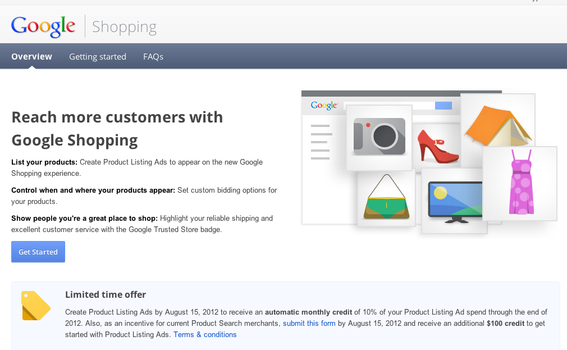It’s been a month of heated debate and speculation since Google announced its intention to phase out free listings on its comparison shopping engine, Google Product Search, and transition to paid listings built on Product Listing Ads for its new initiative, Google Shopping. Google explained its shift in “Building a better shopping experience,” a May 31 blog post.
Google’s stance as stated in this announcement is that “having a commercial relationship with merchants will encourage them to keep their product information fresh and up to date” which “should mean better shopping results for users, which in turn should create higher quality traffic for merchants.”
Google Shopping: A Better Shopping Experience?
One of my clients is Steve Spangler Science, an online retailer of educational science toys and kits that currently uses Google Product Search, and plans on using Google Shopping.
Shawn Campbell is the creative director at Steve Spangler Science. He believes Google Shopping could ultimately benefit merchants. He said, “Google is attempting to create a better shopping experience for the consumer. In that regard, the transition to Google Shopping could be beneficial to all of us. However, in this new product discovery experience, bidding wars will be won by the highest bidder but not necessarily by the highest authority. There’s no guarantee that the highest ranked result will have the consumer’s interests in mind.”
Whether you believe the shift to Google Shopping is positive, negative or a bit of both, this update will impact online merchants. When the full transition to Google Shopping is complete — expected October 2012, just in time for the retail holiday season — merchant rankings will be based on both bid price and relevance, with a ranking algorithm similar to paid search. And while Google purports this model will give merchants greater control over where their products appear within Google Shopping, many argue this move marks the end of smaller merchants’ ability to compete with the big name brands.

Google Shopping, a paid shopping engine, is replacing Google Product Search, which is free to merchants.
Take Advantage of Google’s Incentives
Online retailers need to act quickly to avoid traffic and revenue loss due to Google’s shift. Because the Paid Listing Ads model — i.e. “PLA” — is the basis for Google Shopping, retailers with experience managing PLAs have an advantage currently over retailers with no paid search experience. To incent retailers to get on the bandwagon, Google is offering timely incentives, as follows.
- Merchants who create Product Listing Ads by August 15, 2012 will receive a monthly credit for 10 percent of their total Product Listing Ad spending amounts through the end of 2012; and
- Existing Google Product Search merchants can receive a $100 AdWords credit toward Product Listing Ads if they fill out a form before August 15, 2012.
To learn more and get started merchants can visit Google Shopping.
Though we are already seeing some visible changes as Google tests PLA displays in its search results this summer, there is ongoing debate over the extent of Google Shopping’s effect on ecommerce. Some argue that the larger screen real estate needed for Google Shopping’s “Sponsored Link” area will result in reduced Google AdWords space, which could impact merchant’s current bidding strategies.
Still others question whether Google will stop its new paid inclusion model at Google Shopping, or whether it has plans to extend the new policy to other Google products like Google News or Google Places. Some observers even wonder whether this is a first step in paid inclusion for Google’s web search.
4 Steps to Prepare for Google Shopping
But speculation aside, Google Shopping is coming and online merchants wanting to “pay to play” for the holiday season need to be ready. Here are my suggestions for staying ahead of the game:
- Utilize Google’s incentives. Create PLAs by the August 15th deadline. Get started now in time for the October Google Shopping launch and spend time testing and optimizing your ads. A key distinction PLAs offer over the current Google Product Search listing is the ability to include a line of promotional text with each ad group. Retailers may use this space to announce special pricing, free shipping or offer other incentives to set them apart from their competition.
- Create a bidding strategy. Google Shopping allows merchants to bid on a product or category, with a minimum bid of $0.01. This minimum allows merchants to show in the results for a specific product, but lower in rank than a higher bid by another merchant.
- Optimize your datafeed to adhere to guidelines. Google Shopping ranking will be based on relevancy and bid strategy. So now more than ever, working to improve the quality of the product data you send Google is crucial. In my role as an ecommerce consultant I’ve heard smaller merchants with little time or expertise for datafeed optimization rationalize the act of ignoring Google Product Search warnings. They claim they didn’t pay for it, so whatever traffic and sales Google sends them is fine. With the move to Google Shopping, merchants will need to rethink this strategy in an effort to make the most of their marketing budgets.
Merchants must also adhere to all Google Shopping policies.
- Look into Google Trusted Stores. Since Google has asked online merchants to play a new game, it makes sense to follow Google’s rules. In its May 31 announcement, Google advised merchants wishing to stand out from the crowd to look into its Google Trusted Stores program.
Also, look at the Google Products Feed Specification and the Google Shopping Policies.




